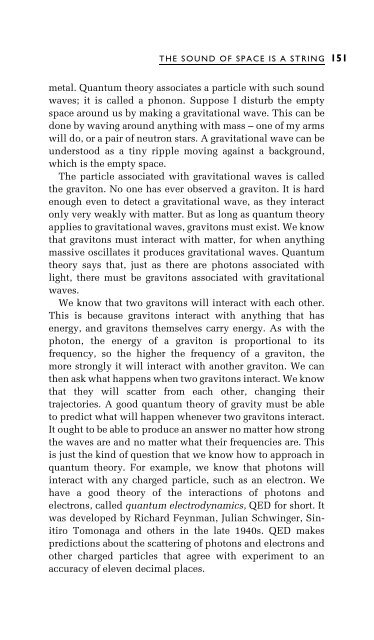Three Roads To Quantum Gravity
Three Roads To Quantum Gravity
Three Roads To Quantum Gravity
You also want an ePaper? Increase the reach of your titles
YUMPU automatically turns print PDFs into web optimized ePapers that Google loves.
THE SOUND OF SPACE IS A STRING<br />
151<br />
metal. <strong>Quantum</strong> theory associates a particle with such sound<br />
waves; it is called a phonon. Suppose I disturb the empty<br />
space around us by making a gravitational wave. This can be<br />
done by waving around anything with mass ± one of my arms<br />
will do, or a pair of neutron stars. A gravitational wave can be<br />
understood as a tiny ripple moving against a background,<br />
which is the empty space.<br />
The particle associated with gravitational waves is called<br />
the graviton. No one has ever observed a graviton. It is hard<br />
enough even to detect a gravitational wave, as they interact<br />
only very weakly with matter. But as long as quantum theory<br />
applies to gravitational waves, gravitons must exist. We know<br />
that gravitons must interact with matter, for when anything<br />
massive oscillates it produces gravitational waves. <strong>Quantum</strong><br />
theory says that, just as there are photons associated with<br />
light, there must be gravitons associated with gravitational<br />
waves.<br />
We know that two gravitons will interact with each other.<br />
This is because gravitons interact with anything that has<br />
energy, and gravitons themselves carry energy. As with the<br />
photon, the energy of a graviton is proportional to its<br />
frequency, so the higher the frequency of a graviton, the<br />
more strongly it will interact with another graviton. We can<br />
then ask what happens when two gravitons interact. We know<br />
that they will scatter from each other, changing their<br />
trajectories. A good quantum theory of gravity must be able<br />
to predict what will happen whenever two gravitons interact.<br />
It ought to be able to produce an answer no matter how strong<br />
the waves are and no matter what their frequencies are. This<br />
is just the kind of question that we know how to approach in<br />
quantum theory. For example, we know that photons will<br />
interact with any charged particle, such as an electron. We<br />
have a good theory of the interactions of photons and<br />
electrons, called quantum electrodynamics, QED for short. It<br />
was developed by Richard Feynman, Julian Schwinger, Sinitiro<br />
<strong>To</strong>monaga and others in the late 1940s. QED makes<br />
predictions about the scattering of photons and electrons and<br />
other charged particles that agree with experiment to an<br />
accuracy of eleven decimal places.



![arXiv:1001.0993v1 [hep-ph] 6 Jan 2010](https://img.yumpu.com/51282177/1/190x245/arxiv10010993v1-hep-ph-6-jan-2010.jpg?quality=85)


![arXiv:1008.3907v2 [astro-ph.CO] 1 Nov 2011](https://img.yumpu.com/48909562/1/190x245/arxiv10083907v2-astro-phco-1-nov-2011.jpg?quality=85)








![arXiv:1002.4928v1 [gr-qc] 26 Feb 2010](https://img.yumpu.com/41209516/1/190x245/arxiv10024928v1-gr-qc-26-feb-2010.jpg?quality=85)
![arXiv:1206.2653v1 [astro-ph.CO] 12 Jun 2012](https://img.yumpu.com/39510078/1/190x245/arxiv12062653v1-astro-phco-12-jun-2012.jpg?quality=85)
